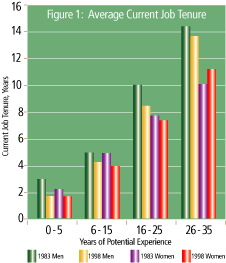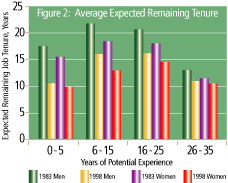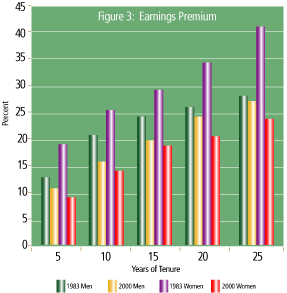Keep Your Résumé Current: The Causes Behind Declining Job Tenure
Over the past quarter-century, it has become remarkably less common for people to work for the same employer for most of their working lives. The reduction in tenure can have a number of effects on the labor market, including a decline in the tendency of employers to offer tenure-based benefits such as traditional pensions. Policy-makers must be wary of these changes because they may affect the costs associated with frequent changes in employees' health care plans, increased rates of 401(k) plan rollovers, and reallocation of resources to job search and vacancy posting.
An examination of the trends shows that the average return on each additional year of tenure has fallen for both workers and employers. Possible causes for the decline in tenure are changes in demographics, changes in technology and changes in such labor-market institutions as unions and international trade.
Basic Facts on Job Tenure
Economists Leora Friedberg and Michael Owyang computed changes in average job tenure between 1983 and 1998 for full-time workers aged 22-59. Figure 1 shows average tenure in one's current job, broken down by sex and years of potential experience in the workforce.1 For men, average job tenure steadily declined, from 9.2 years in 1983 to 8.6 years in 1998. During this period, average tenure fell by 1.1 years for men with 0-5 years of potential experience, a particularly sharp decline at that stage of the career, while those with 16-25 years of potential experience witnessed a decline of 1.4 years. Males with 6-15 years of potential experience saw a smaller, yet still significant, decline of 0.6 years.2
Friedberg and Owyang found related, though more complex, trends for women. Their average tenure actually rose from 7.2 years in 1983 to 7.9 years in 1992 before falling again to 7.2 years in 1998. The rise over the intervening period at least partly reflects the increased tendency of women to be in the labor force. The change in overall average tenure between 1983 and 1998 looks different for younger vs. older women for reasons we address later. For women with 15 years or less of potential experience, overall average tenure declined by a little less than one year. In contrast, women with 26-35 years of potential experience saw their average job tenure increase by 1.2 years.
The most recent Bureau of Labor Statistics release on employee tenure highlights these trends, focusing on reductions in the percentage of workers who have at least 10 years of tenure with their current employer, which is one way to think about a long-term tenure rate. Not surprisingly, each age category for men shows a drop in this long-term tenure rate between January 1983 and January 2004, with an overall decline of approximately 5 percentage points.
The story for women again differs from men's—an overall increase of almost 4 percentage points—for the same reasons as above.
Most of the recent literature, including several 1999 studies primarily conducted by economists, confirms that job tenure has fallen since the 1980s.3 However, some disagreement remains, depending on the source of the data for the study, although analyses using most data sets show the same results that Friedberg and Owyang found.4
Expected Remaining Tenure
Friedberg and Owyang also tracked changes in expected remaining tenure—the number of years that employees expect to continue working for their current employer—over the 1983-98 period. Figure 2 gives a graphical representation of expected remaining tenure, broken down by sex and years of potential experience in the workforce. They found that for each level of potential work experience, both sexes experienced declines in expected remaining tenure over the entire period. For both sexes, the decline in expected remaining tenure was greater for more-educated workers than for less-educated workers.
Expected remaining tenure for males fell from 18.0 years in 1983 to 15.9 years in 1992 and then to 14.1 years in 1998. Expected remaining tenure declined the most among men with the least potential work experience. For instance, those with 0-5 years saw it fall from 18.3 years in 1983 to 16.7 in 1992 and finally to 10.6 in 1998, for a total of 7.7 years. Those in the 6-15 years category saw a 5.7-year decline in expected remaining tenure, whereas expected remaining tenure among workers with 16-25 and 26-35 years of potential experience declined by 3.9 and 2.2 years, respectively.
The same pattern holds for women, in contrast to the swings in current tenure. Females with less than 15 years of potential experience saw the largest declines in expected remaining tenure, of over 5 years. These findings show that the decline in job tenure does not reflect a one-time job switch, but, instead, a general shift in workers' expectations of holding more jobs over their lifetime. What changes might have occurred in the last quarter-century to change workers' expectations about long-term jobs?
Value of Long-Term Jobs to Workers
A key reason that workers might switch jobs more frequently is a decline in the gains from staying in a job for a long period of time. If, for each additional year at their current jobs, earnings growth is smaller than it used to be, then workers have less to lose if they leave. Friedberg and Owyang measured the tenure premium as the additional earnings paid to the average worker for each year of tenure, compared with the earnings of a worker just starting a job. Figure 3 graphs the changes in the earnings premium over the sample period.
For all tenure levels, the tenure premium for men fell significantly between 1983 and 2000, with the biggest decreases seen for those with moderate tenure. At 10 years of tenure, the premium initially rose from 20.4 percent in 1983 to 24.7 percent in 1991 above earnings in new jobs, only to fall again to 16.5 percent in 2000.
For women, the drop-off in the tenure premium was much more substantial. Women with 10 years of experience initially saw an increase from 25.5 percent in 1983 to 28.5 percent in 1996, but then the premium plummeted to 14.6 percent in 2000. Such is the case for each tenure level for women.
Friedberg and Owyang provide evidence linking the declines in average tenure and the earnings premium for tenure. They looked across industries and discovered that for each one-year decline in average tenure in a given industry, the tenure premium declined by 2.7 percentage points. All of these results indicate that the returns to tenure have fallen in the past couple of decades. That may imply that workers no longer place as much value on holding a long-term job as they did in the past. At the same time, it might signal a decline in the value of long-term employment from a firm's perspective.
The following sections examine the worker's and employer's views of why the value of long tenure may have declined.
Demographics
Age
The age profile of displaced workers has undergone changes in recent decades and has reduced average job tenure. The representation of older workers within that group has increased, meaning that they now possess a weaker sense of job security than in the past.
Economists Daniel Rodriguez and Madeline Zavodny studied workers who have been laid off from their job to determine changes in the characteristics of displaced workers between 1983-87 and 1993-97.5 Workers aged 25-34 continue to suffer displacement more frequently than older workers. However, the displacement rate fell for the younger group between the two periods, but it rose for older workers during this time. In fact, even among the older workers, the probability of becoming displaced increased significantly more for those aged 45-64 than it did for workers aged 35-44.
What do those results suggest about job tenure? The combination of an increased likelihood of displacement among middle-aged workers and a decrease among the youngest workers exerts downward pressure on overall average tenure. This is true because the older group, which would have longer average tenure, has become more susceptible to displacement, whereas the younger group, which has shorter tenure on average, is experiencing less displacement.
Sex
Over the course of the past few decades, women's average job tenure has been affected by two opposing forces. On one hand, the factors that have exerted negative influence on men's tenure also affected women's tenure. On the other hand, an increase in the proportion of career-oriented women has raised women's average job tenure. Economist Karen Lombard found that between 1975 and 1991, women's exit rates from employment declined, especially among those with young children. This led to an increase in tenure that outweighed the negative forces experienced by both sexes. As women's labor force participation stabilized in the 1990s, other effects, such as those discussed in the following sections, became dominant, and women's tenure fell.
Technology
The surge in technological advancement, especially in computer use, during the past 25 years has affected labor markets in numerous ways. Many new technologies are thought to be "skill-biased"—that is, replacing unskilled workers while raising the demand for skilled workers. For example, technological advancements have replaced workers in many areas of financial operations, inventory control and other clerical tasks. On the other hand, many new technologies require workers to acquire new skills to design and operate them. Additional evidence shows that new technologies require not just greater but also new skills, including not only computer use but also other more complex decision-making tasks left over by the automation of routine tasks. All these factors suggest that technological changes, which may have grown more rapid in recent years, induce a reshuffling of workers with different sets of skills across jobs.
Rodriguez and Zavodny provided evidence that technological innovations have led to more rapid churning of skilled workers through jobs, even while raising overall demand for skilled relative to unskilled workers. This increase in job flow due to technological change leads to a decline in average tenure because these workers are switching jobs more often than in the past. For example, although a college graduate's likelihood of displacement remained lower than that of a person who did not complete high school during the 1983-87 and 1993-97 periods, the probability of becoming displaced increased more for the college graduate between the two sample periods. This demonstrates that some technological advances place more rigorous demands on the level of skill required for operation, causing skilled workers to be negatively affected by job loss in these cases.
In a separate paper, Zavodny studied the relationship between technology and the rates of job separation among young adult men. She found that, in industries with higher ratios of scientists and engineers to total employment, which she took as an indicator of technology intensity, college graduates were much more likely to voluntarily leave a job, while nongraduates were more often terminated. This distinction signals a shift toward higher demand for skilled workers and lowered demand (via job destruction) for unskilled workers.
In order to estimate the overall relationship between technology and average job tenure, Friedberg and Owyang used various indicators of technology based on measurements at individual firms, including the proportion of workers who use computers, the rates of investment and the level of the physical capital, such as machinery and computers. They found that increases in these measures led to subsequent decreases in average job tenure. This relationship was stronger after 1990 than before, suggesting a change in the nature of new technology. For example, comparing an industry with the 75th percentile level of computer use after 1990 (in which 67 percent of workers use computers) to one with the 25th percentile level (in which 36 percent of workers use computers) job tenure was, on average, a third of a year lower in the former. Similarly, comparing an industry with the 75th percentile level of investment to one with the 25th, job tenure was, on average, over half of a year lower in the higher-investing industry.
Thus, technological advances seem to have increased the churning of workers through jobs, thereby pushing average job tenure downward. The effects on workers of different types of skills are difficult to disentangle, but it appears as though technological change sometimes renders unskilled workers' jobs obsolete, while it, for the most part, creates more mobility for skilled workers.
Institutional Changes
Decline in Union Membership
For the past few decades, unionization rates have suffered a steady decline. The Bureau of Labor Statistics reported that between 1983 and 2003, the fraction of wage and salary workers who belonged to a union fell from 20.1 percent to 12.9 percent. How would this affect job tenure? Workers who belong to unions typically enjoy benefits that their nonunionized counterparts do not, including more job security. Although different studies draw opposing conclusions on how unions influence layoff rates, the studies agree that job security increases with tenure in unionized jobs. For instance, economists Katharine Abraham and James Medoff conducted a study of the private sector and measured the percentage of employee groups paid hourly in which layoffs are governed strictly by tenure. They found that the fraction of unionized groups that were governed by this rule was twice as large as the fraction for nonunionized groups.
Another advantage of unionization is higher wages for unskilled workers. Economist David Card compared wages by union status and skill level. He found that a less-skilled male union worker (in any of the four lowest skill deciles) had a 29 percent higher average wage than a comparable nonunion worker, but that this gap disappears as skill level rises. The decline in unionization may have, therefore, reduced the incentives for unskilled workers to remain with their current employers for such an extensive amount of time because they may be less attached to these now lower-paying, nonunionized jobs.
In 2002, economists Toke Aidt and Zafiris Tzannatos reported that firms that employ union members tend to have fewer voluntary quits and higher job tenure among employees. Combining higher job security (at least for more tenured workers) and higher wages, one can see how unionized workers would also have lower rates of voluntary quits and, therefore, higher job tenure on average than their nonunion counterparts. Thus, the decline in union membership implies increased worker turnover, both voluntary and involuntary.
Increased International Trade
Increasing globalization in recent decades has had an impact on labor markets both positively and negatively. One of the most obvious negative effects of increased international trade has been job loss and its associated costs in import-competing industries. Economist Lori Kletzer focused on the effect of globalization for industries with different levels of import competition.6 Between 1979 and 1999, 16.8 million manufacturing workers were displaced, accounting for approximately 37 percent of total displacements among nonagricultural payroll workers. However, the manufacturing sector accounted for only 18 percent of total employment. Thus, a higher proportion of workers in manufacturing experienced displacement relative to those in nonmanufacturing sectors of the economy. Kletzer calculated that the average displaced manufacturing worker was 1.3 years older and had nearly two more years of tenure than the average displaced nonmanufacturing worker. Consequently, the average tenure of still-employed workers declined to some degree.
Because of the importance of international trade to manufacturing, Kletzer compared the characteristics of displaced workers in high, medium and low import-competing manufacturing industries. She calculated the average tenure of a displaced worker to be 0.9 years higher in industries facing high competition from imports than in industries facing low competition from imports. Again, the proportion of displaced workers from high import-competing industries (e.g. apparel, electrical machinery, radio and television, footwear, toys) outweighed their proportion of the total manufacturing employment. The conclusion is that increasing amounts of import competition has displaced workers with higher tenure than average.
Discussion
None of the factors that have been discussed in this article can provide a full explanation by itself for declining job tenure; even when combined, they can provide only a partial explanation.
The trends are outward signs of an ever-changing labor market, where workers should not be surprised if their job today is different from the year before. The trends themselves are not necessarily cause for concern; however, a concomitant fall in the general welfare of the population would indicate that workers somehow need to be compensated for this increased job instability.
Endnotes
- Potential work experience is defined as age minus the number of years of education minus six. [back to text]
- Similar declines were observed across all education groups. [back to text]
- See, for example, Neumark, Polsky and Hansen (1999), and Jaeger and Stevens (1999). [back to text]
- See, for instance, Gottschalk and Moffitt (1999). [back to text]
- Rodriguez and Zavodny focused only on displaced workers who lost jobs due to plant closure, job abolishment or slack work. [back to text]
- Kletzer defines a high import-competing industry as one that was in the top quartile after measuring the percentage change in the industry's import share from 1979 to 1994. [back to text]
References
Abraham, Katharine G. and Medoff, James L. "Length of Service and Layoffs in Union and Nonunion Work Groups. " Industrial and Labor Relations Review, Vol. 38, No. 1, October 1984, pp. 87-97.
Aidt, Toke and Tzannatos, Zafiris. Unions and Collective Bargaining: Economic Effects in a Global Environment. Washington, D.C.: World Bank, 2002.
Card, David. "Falling Union Membership and Rising Wage Inequality: What's the Connection?" Working Paper No. 6520, National Bureau of Economic Research, April 1998.
Friedberg, Leora and Owyang, Michael. "Explaining the Evolution of Pension Structure and Job Tenure." Working Paper No. 10714, National Bureau of Economic Research, August 2004.
Gottschalk, Peter and Moffitt, Robert. "Changes in Job Instability and Insecurity Using Monthly Survey Data." Journal of Labor Economics, Vol. 17, No. 4, Part 2, October 1999, pp. S91-S126.
Jaeger, David A. and Stevens, Ann Huff. "Is Job Stability in the United States Falling? Reconciling Trends in the Current Population Survey and Panel Study of Income Dynamics." Journal of Labor Economics, Vol. 17, No. 4, Part 2, October 1999, pp. S1-S28
Kletzer, Lori G. Job Loss from Imports: Measuring the Costs. Washington, D.C.: Institute for International Economics, 2001.
Lombard, Karen V. "Women's Rising Market Opportunities and Increased Labor Force Participation." Economic Inquiry, Vol. 37, No. 2, April 1999, pp. 195-212.
Neumark, David; Polsky, Daniel; and Hansen, Daniel. "Has Job Stability Declined Yet? New Evidence for the 1990s." Journal of Labor Economics, Vol. 17, No. 4, Part 2, October 1999, pp. S29-S64.
Rodriguez, Daniel and Zavodny, Madeline. "Changes in the Age and Education Profile of Displaced Workers." Industrial and Labor Relations Review, Vol. 56, No. 3, April 2003, pp. 498-510.
Zavodny, Madeline. "Technology and Job Separation among Young Adults, 1980-98." Economic Inquiry, Vol. 41, No. 2, April 2003, pp. 264-78.
Views expressed in Regional Economist are not necessarily those of the St. Louis Fed or Federal Reserve System.
For the latest insights from our economists and other St. Louis Fed experts, visit On the Economy and subscribe.
Email Us






